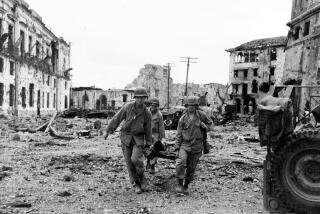40th Anniversary of Liberation of Manila
- Share via
In regard to the 40th anniversary tomorrow of the Liberation of Manila in World War II, I thought your readers might be interested in a firsthand account of what took place there.
Forty years ago, on Feb. 3, 1945, the First Cavalry Division, in which I was a staff sergeant in H Troop, 5th Cavalry Regiment, entered the University of Santo Tomas in Manila, to free the thousands of American and British civilians who had been interned there for three years by the Japanese army.
On the 27th of January, 1945, we had landed at Lingayen Gulf on Luzon Island. On Jan. 30th we were in Gumba, where Gen. Douglas MacArthur issued orders for us to proceed to Manila and free the internees at Santo Tomas. Gen. Chase, our division commander, was issued orders to take some units of the 1st Cavalry Division, including mine, on a 100-mile dash through Japanese-held territory to accomplish this mission.
On Feb. 1 we entered the city of Cabanatuan. Here we supported the Sixth Rangers, a commando-like unit of the U.S. Army, in freeing the prisoners at a camp there. Some of these prisoners were survivors of the “Death March” in 1942.
On Feb. 2 we continued south, being fired upon by Japanese army units still in the vicinity. Several times we were forced to come to a halt, leave our vehicles and return fire. Several in our unit were wounded at this time.
We reached the city of Angot and discovered that all bridges had been destroyed. We had to ford the rivers, our tanks pulling the trucks across. That night Gen. Chase set up a command post in a house where Japanese Gen. Yamasita had been quartered only a few days earlier.
On Feb. 3 we entered the outskirts of Manila. Here we were met with a lot of resistance from the enemy and plenty of action. As we continued toward the city we passed a Chinese cemetery and were fired upon by Japanese soldiers hidden behind the tombstones. As darkness fell, a Japanese convoy, having become confused, tried to join our convoy. They soon retreated. Later, they approached our convoy again, from the rear, but were repulsed by quick action from our machine guns, which were mounted on our trucks.
We were within a few hundred yards of the University of Santo Tomas, in the darkness, when we began to pass many buildings, which were being blown up by the enemy. Many were burning, and the light from these fires aided us in reaching our destination. We entered the university grounds behind one of the two tanks of the 44th Tank Battalion of the 1st Cavalry Division accompanying us. This tank was nicknamed “Battling Basic,” the other was called “Georgia Peach.” The tank crashed through the gates and incidentally brought to a halt a large American Packard car filled with Japanese officers attempting to escape.
We secured the buildings and stood guard all night, having completely surrounded the grounds. Some of the prisoners came rushing out to greet us, expressing their great joy and relief. Some were speechless in their amazement at seeing us there. By their general physical appearance it was obvious that they had suffered much deprivation and mistreatment. Some told us that the previous day an American plane had flown over the prison camp and dropped a goggle case in which was a note reading, “Roll out the barrel. There’ll be a hot time in the old town tonight!”
An excellent book, “Infamous Santo Tomas,” written by Tresa R. Cates, a nurse who kept a diary, at the risk of her life, during her imprisonment there, gives a detailed, personal account of the treatment of the American and British prisoners of the Japanese at Santo Tomas.
On the afternoon of Feb. 4 some of our unit was dispatched to secure the Jones Bridge over the Pasig River in Manila. We encountered heavy weapon fire. I was wounded in this action and was awarded the Purple Heart.
HENRY J. ANNASENZ
Alhambra
Annasenz was a first sergeant in H Troop, 5th Cavalry Regiment of the 1st Cavalry Division.

